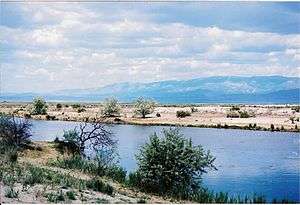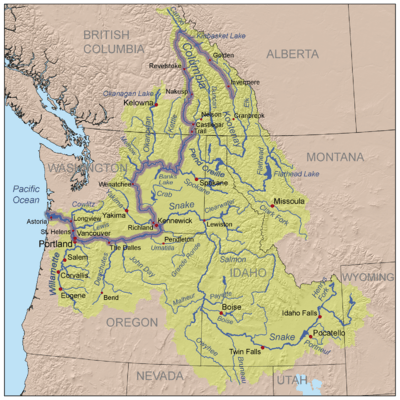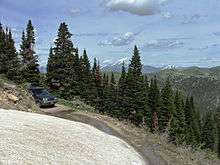Raft River Mountains
The Raft River Mountains are a mountain range in northern Box Elder County, Utah, United States.[1][2] The mountains are located in Raft River Division of the Minidoka Ranger District of Sawtooth National Forest. The highest point is Bull Mountain near the Dunn Benchmark at 9,925 ft (3,025 m), and the ghost town of Yost is on the north central slopes.[3][4][5] Tributaries of the Raft River drain the northern slopes of the range to the Snake River then Columbia River and Pacific Ocean, while the southern slopes drain to the Great Salt Lake.
| Raft River Mountains | |
|---|---|
 Raft River Mountains from the southeast | |
| Highest point | |
| Peak | Bull Mountain |
| Elevation | 9,925 ft (3,025 m) |
| Coordinates | 41°54′42″N 113°21′55″W |
| Dimensions | |
| Length | 40 mi (64 km) E/W |
| Width | 35 mi (56 km) N/S |
| Area | 765 sq mi (1,980 km2) |
| Geography | |
| Country | United States |
| State | Utah |
| Parent range | Basin and Range Province |
Geography
Located in the Sawtooth National Forest,[6] the range's montane forest ecoregion is "surrounded by montane steppes and desert".[7] The range is oriented in an east–west orientation, and is a portion of the Great Basin Divide and the Basin and Range Province between the Bonneville Basin of the Great Basin (south).[7]

Geology
The central mass of the range consists of Precambrian metamorphic rocks.[8] The Elba Quartzite with interlayered schist outcrops along the southern slopes of the range and in the Grouse Creek Mountains to the southwest. Cambrian quartzite outcrops in the west part of the range and in the Grouse Creek range and the Goose Creek Mountains to the west. The thinly bedded quartzites have been quarried for building stone in the area.[9]
Flora and fauna
The range's plants and animals include pines and rodents of the Northern Basin & Range ecoregion of the Columbia Plateau.[7]
Camping and activities
The range's Bull Flat trail leads to Bull Flat, Bull Lake, and Bull Mountain, and passes former mines (the trailhead is near a campground).[10]
Peaks

| Mountain Peak | Elevation | Prominence | Isolation | Location |
|---|---|---|---|---|
| Bull Mountain | 9,925 ft 3025 m | 3,725 ft 1135 m | 24.3 mi 39.2 km |
41.9117°N 113.3654°W |
| George Peak | 9,601 ft 2926 m | 581 ft 177 m | 6.21 mi 9.99 km |
41.8893°N 113.4831°W |
| Peak 9,335 | 9,335 ft 2845 m | 515 ft 157 m | 3.14 mi 5.05 km |
41.9296°N 113.4211°W |
| Peak 8,402 | 8,402 ft 2561 m | 582 ft 177 m | 2.03 mi 3.27 km |
41.9143°N 113.5039°W |
| Mahagony Peaks | 8,340 ft 2542 m | 480 ft 146 m | 4.93 mi 7.93 km |
41.8809°N 113.5884°W |
| Peak 8,220 East | 8,220 ft 2505 m | 320 ft 98 m | 2.8 mi 4.51 km |
41.8649°N 113.5384°W |
| Peak 8,220 West | 8,220 ft 2505 m | 320 ft 98 m | 1.85 mi 2.98 km |
41.8621°N 113.5628°W |
| Peak 8,140 | 8,140 ft 2481 m | 738 ft 225 m | 2.45 mi 3.94 km |
41.8724°N 113.6357°W |
| Bally Mountains High Point | 8,060 ft 2457 m | 671 ft 205 m | 3.59 mi 5.78 km |
41.9638°N 113.4737°W |
| Peak 7,980 | 7,980 ft 2432 m | 440 ft 134 m | 6.32 mi 10.17 km |
41.8976°N 113.2443°W |
| Peak 7,875 | 7,875 ft 2400 m | 336 ft 102 m | 2.94 mi 4.73 km |
41.8694°N 113.3515°W |
| Crystal Peak | 7,780 ft 2371 m | 354 ft 108 m | 1.69 mi 2.72 km |
41.9188°N 113.2278°W |
| Bald Knoll | 7,484 ft 2281 m | 474 ft 144 m | 2.84 mi 4.57 km |
41.8643°N 113.2766°W |
| Black Hills High Point | 7,100 ft 2164 m | 400 ft 122 m | 2.07 mi 3.33 km |
41.8337°N 113.5503°W |
References
- "Raft River Mountains". PeakBagger. Retrieved 2012-05-10.
- "Raft River Mountains". Geographic Names Information System. United States Geological Survey.
- "Sawtooth National Forest - Raft River Division". Geographic Names Information System. United States Geological Survey.
- U.S. Forest Service, U.S. Department of Agriculture. "Sawtooth National Forest". Retrieved 2012-05-09.
- Summitpost.org. "Bull Mtn (UT)". Retrieved 2012-05-10.
- Mohlenbrock, Robert (2006). This land: a guide to western national forests. Los Angeles: University of California Press. pp. 196. ISBN 0-520-23967-9.
- Houseman, R; Baumann, R (31 July 1997). "Zoogeographic affinities of the stoneflies (Plecoptera) of the Raft River Mountains, Utah". Western North American Naturalist (The Great Basin Naturalist). 57 (3): 209–219. JSTOR 41713003.
- 2448, RAFT RIVER MOUNTAINS FAULT, Utah Geological Survey
- Bryce T. Tripp, The Quartzite Building Stone Industry of the Raft River and Grouse Creek, Special Study 84, Utah Geological Survey, 1994
- Steadman, Jeffery (2007). The Best in Tent Camping: Utah. Birmingham, AL: Menasha Ridge Press. pp. 92–94. ISBN 978-0-89732-647-6.
- Staff. "Box Elder County Summits". Lists of John. Retrieved 29 May 2012.